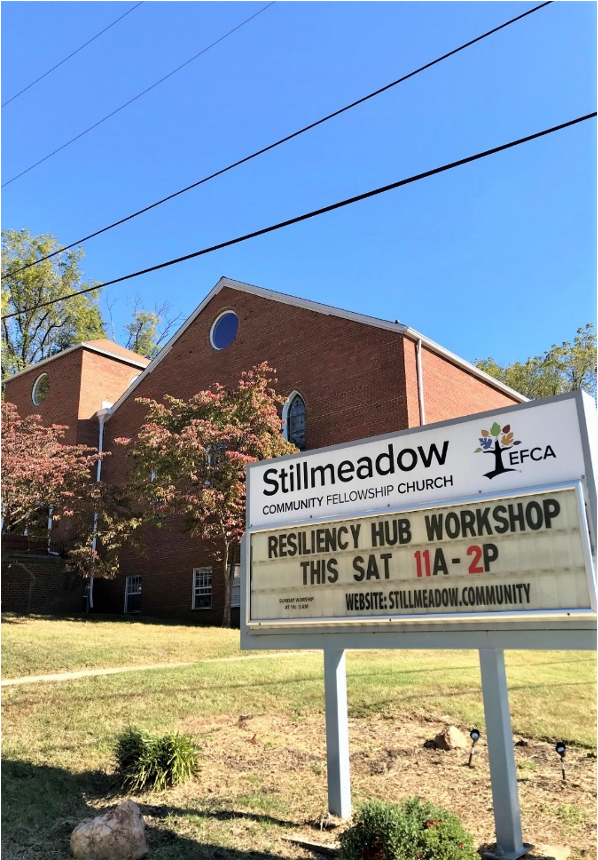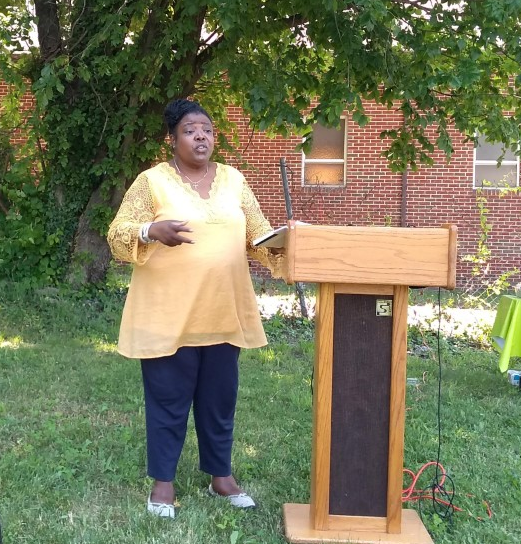All About Baltimore's Community Resiliency Hub Program
An Interview with Aubrey Germ, Community Resiliency Hub Program Manager
 If you’ve been reading the Compass for a while, you may have seen us occasionally provide updates on the progress of Baltimore’s Community Resiliency Hub Program (CRH Program). The National Oceanic and Atmospheric Administration’s Climate Resilience Toolkit defines resilience as “The capacity of a community, business, or natural environment to prevent, withstand, respond to, and recover from a disruption.” But what exactly is a Community Resiliency Hub, and what purposes can they serve in our communities? To answer these questions for those who are curious we spoke to Aubrey Germ, Climate and Resilience Planner and CRH Program manager at the Baltimore Office of Sustainability.
Over an afternoon phone call, Aubrey explains that the CRH Program has existed for around six years, and that the basis of the Resiliency Hub is the local service-based community organization. This could mean a faith institution or a local non-profit organization.
“[These organizations] already have strong leadership in their communities and are doing amazing grassroots level work to support vulnerable community members,” Aubrey explains.
“When they join the CRH Program they basically agree to partner with the City to receive additional support to enhance their own operating capacity and increase the scope of the work that they are able to do in emergency situations.”
The emergency situations that Resiliency Hubs aim to handle can range from individual emergencies to community-wide emergencies, such as those which would be caused by a natural hazard like a flood or extreme heatwave. To increase resilience and resource delivery in the face of emergency, the CRH Program connects Hub partner organizations to Baltimore’s Office of Emergency Management (OEM).
Aubrey describes the relationship between the OEM and the Resiliency Hubs as such: “If and when something happens, the Emergency Management Office knows which organizations are Hubs and therefore, which ones are willing to help get information and resources out to their vulnerable neighbors.”
The CRH Program also offers solar power to those Resiliency Hubs that can host solar panels and battery storage. The purpose of the solar and battery storage initiative, which is largely grant-funded, is to ensure that when there are power outages, the Resiliency Hub partner organizations will have backup power to continue providing critical services for community members. It also helps reduce utility costs for the organization.
“It takes a lot of time, grant funding, and coordination to roll out, but the Hubs that are able to be outfitted with solar and battery storage can then operate when the power goes out and continue providing critical support, including refrigeration for food or medication, or cell phone charging,” Aubrey says of the solar power initiative.
There are currently twelve resiliency hubs in Baltimore City, but the program is rapidly expanding. When asked whether the Resiliency Hubs are established as a result of the city government reaching out to community organizations or vice versa Aubrey responds, “It’s been both.”
Communities and city council members alike have reached out to city government in order to connect with more resilience-building and emergency preparedness resources through the CRH Program. Aubrey has also attended community meetings to hear from residents on which organizations could be great Hubs. She explains that she has been “working with other
planners in the Department of Planning to better understand what organizations and faith groups could be ideal Resiliency Hub partners.”
Two measures by which Aubrey and other planners determine which organizations would make good resiliency hubs are (1) strong leadership and (2) a strong connection to the community it serves. An equally important measure is socioeconomic and/or environmental vulnerability.
“[The process of searching for Resiliency Hub partners has] also been looking at vulnerability maps to better understand where vulnerability exists in the city,” Aubrey explains, “[and] seeing which community organizations might be nearby which could serve as Hubs because there’s high exposure risk in that area.”
Lately, Aubrey has also been monitoring which organizations have been the most responsive to their communities during the pandemic and has been actively reaching out to them in order to establish a partnership.
One of the most important notes about the Resiliency Hubs is that they serve as a key link between city government and communities, and, as such, they provide opportunities for communities and city government agencies to exchange information about needs, goals, and resilience.
“[The Resiliency Hubs] are trusted messengers around preparedness and risk as it pertains to climate, and they can also really help message around what building local resilience looks like.” Aubrey continues, “At its core it’s a two-way mutual partnership between city government agencies, with the Planning Department at the helm, and grassroots community-based organizations that are at the forefront of safety and support in their communities.”
Questions about the Community Resiliency Hub Program? Email: aubrey.germ@baltimorecity.gov
DHCD Calling for Expressions of Interest for Property Development
Baltimore City’s Department of Housing & Community Development (DHCD) is issuing a call for expressions of interest (EOI) to develop several city-owned properties. DHCD is seeking submissions from experienced developers for 12 strategic locations, seven of which are former school buildings. The City aims to continue ongoing, large-scale revitalization efforts through promoting properties in locations that are primed for redevelopment and seeks to determine potential re-use opportunities for these sites. Through the EOI process, the City will establish a list of interested, qualified firms, which could lead to the issuing of Requests for Proposals.
The following properties are included in the current EOI:
- Castle Street Bundle (1900 blocks of N. Castle and N. Chester St. and 2025 E. 20th St.)
- North Mount Street Bundle (517-541 N. Mount Street)
- Reisterstown Road Bundle (4419 and 4431 Reisterstown Road)
- 301 N. Pulaski Street (Lockerman Bundy)
- 411 E. Old Cold Spring Lane (Guilford)
- 800 Poplar Grove Street (Alexander Hamilton)
- 1101 Winston Avenue (Winston)
- 1200 N. Fremont Avenue (Pinderhughes)
- 1600 E. Arlington Avenue (Lois T Murray)
- 1630 N. Patterson Park Avenue
- 1807 Harlem Avenue (Harriet Tubman)
- 2650 Quantico Avenue
The deadline to submit an EOI for the listed properties is Tuesday, July 28, by 11:59 p.m. (EST). Learn more.
Learn more about surplus schools here.
Presentation on Victorine Q. Adams at the Cab Calloway Legends Park

Cab Calloway Legends Park, a Baltimore Green Network pilot project, kicked off its season with a presentation on Baltimore City's first female Black Councilmember Victorine Q. Adams on June 5. The presentation was co-sponsored by Druid Heights Community Development Corporation and the Baltimore Dept. of Planning.
Dr. Ida E. Jones, author of "Civil Rights Leader Victorine Q. Adams," spoke to the crowd about Councilmember Adams' legacy. Several highlights of Councilmember Adams' career included voter registration drives to register more Black voters and helping to elect Black candidates to local and state offices. This would include Harry Cole who became Maryland's first male Black State Senator in 1954 and Verda Welcome who became the first female Black candidate to become a State Senator in the United States when she was elected to the Maryland State Senate in 1962. Councilmember Adams also mentored politicians such as former Senator Barbara Mikulski and Congressman Kweisi Mfume. Councilmember Adams helped to get the Social Security Office located in downtown Baltimore in order to bring more jobs to the city's residents as well, and started the private-public Baltimore Fuel Fund to help families stay warm during the winter months.
|
 |
From left to right, Dr. Ida E. Jones, presenter, Druid Heights CDC Executive Director Anthony Pressley, and Patterson-Asbury AME Zion Church's Pastor Ingrid Gant
|